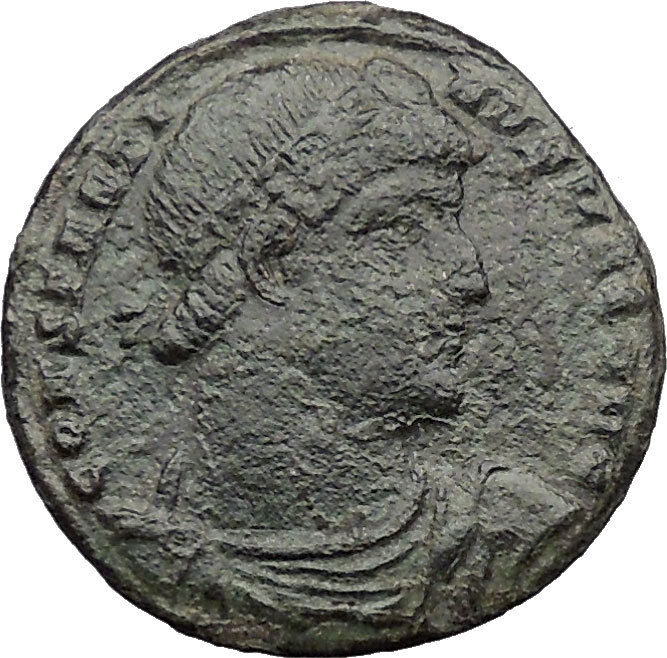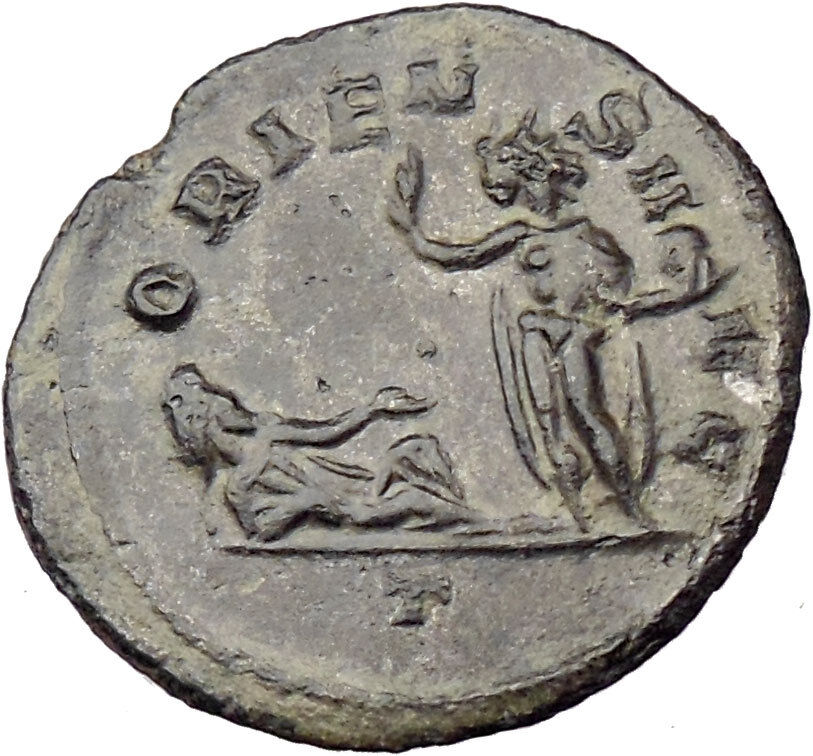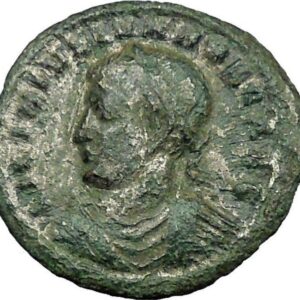|
Severus Alexander
–
Roman Emperor
: 222-235 A.D.
Silver Denarius 18mm (2.28 grams) Rome mint: 231 A.D.
Reference: RIC 193, S 7863, C 51
IMPSEVALEXANDAVG – Laureate head right.
FIDESMILITVM – Fides seated left, holding a standard in each hand.
You are bidding on the exact item pictured,
provided with a Certificate of Authenticity and Lifetime Guarantee of
Authenticity.
Standards
.jpg/400px-035_Conrad_Cichorius,_Die_Reliefs_der_Traianssäule,_Tafel_XXXV_(Ausschnitt_01).jpg)
Roman military standards. The standards with discs, or signa
(first three on left) belong to centuriae of the
legion (the image does not show the heads of the standards – whether
spear-head or wreathed-palm). Note (second from right) the
legion’s
aquila
. The standard on the
extreme right probably portrays the
She-wolf
(lupa) which fed
Romulus
, the legendary founder of
Rome. (This was the emblem of
Legio VI Ferrata
, a legion then
based in
Judaea
, a detachment of which is
known to have fought in Dacia). Detail from Trajan’s Column, Rome

Modern reenactors parade with replicas of various legionary
standards. From left to right: signum (spear-head type), with
four discs; signum (wreathed-palm type), with six discs;
imago of ruling emperor; legionary aquila; vexillum
of commander (legatus) of
Legio XXX Ulpia Victrix
, with
embroidered name and emblem (Capricorn) of legion
Each tactical unit in the imperial army, from centuria upwards, had
its own standard. This consisted of a pole with a variety of adornments that was
borne by dedicated standard-bearers who normally held the rank of duplicarius.
Military standards had the practical use of communicating to unit members where
the main body of the unit was situated, so that they would not be separated, in
the same way that modern tour-group guides use umbrellas or flags. But military
standards were also invested with a mystical quality, representing the divine
spirit (genius) of the unit and were revered as such (soldiers frequently
prayed before their standards). The loss of a unit’s standard to the enemy was
considered a terrible stain on the unit’s honour, which could only be fully
expunged by its recovery.
The standard of a centuria was known as a signum, which was
borne by the unit’s signifer. It consisted of a pole topped by either an
open palm of a human hand or by a spear-head. The open palm, it has been
suggested, originated as a symbol of the
maniple
(manipulus = “handful”), the
smallest tactical unit in the
Roman army of the mid-Republic
. The poles were
adorned with two to six silver discs (the significance of which is uncertain).
In addition, the pole would be adorned by a variety of cross-pieces (including,
at bottom, a crescent-moon symbol and a tassel). The standard would also
normally sport a cross-bar with tassels.[194]
The standard of a Praetorian cohort or an auxiliary cohort or ala was
known as a vexillum
or banner. This was a square flag,
normally red in colour, hanging from a crossbar on the top of the pole. Stitched
on the flag would be the name of the unit and/or an image of a god. An exemplar
found in Egypt bears an image of the goddess Victory on a red background. The
vexillum was borne by a vexillarius. A legionary detachment (vexillatio)
would also have its own vexillum. Finally, a vexillum
traditionally marked the commander’s position on the battlefield.[194]
The exception to the red colour appears to have been the Praetorian Guard, whose
vexilla, similar to their clothing, favoured a blue background.
From the time of
Marius
(consul 107 BC), the standard of all
legions was the
aquila
(“eagle”). The pole was surmounted
by a sculpted eagle of solid gold, or at least gold-plated silver, carrying
thunderbolts in its claws (representing
Jupiter
, the highest Roman god. Otherwise the
pole was unadorned. No exemplar of a legionary eagle has ever been found
(doubtless because any found in later centuries were melted down for their gold
content).[194]
The eagle was borne by the aquilifer, the legion’s most senior
standard-bearer. So important were legionary eagles as symbols of Roman military
prestige and power, that the imperial government would go to extraordinary
lengths to recover those captured by the enemy. This would include launching
full-scale invasions of the enemy’s territory, sometimes decades after the
eagles had been lost e.g. the expedition in 28 BC by
Marcus Licinius Crassus
against
Genucla
(Isaccea, near modern
Tulcea
, Rom., in the Danube delta region), a
fortress of the Getae
, to recover standards lost 33 years
earlier by
Gaius Antonius
, an earlier
proconsul
of
Macedonia
.[195]
Or the campaigns of AD 14-17 to recover the three eagles lost by
Varus
in AD 6 in the
Teutoburg Forest
.
Under Augustus, it became the practice for legions to carry portraits (imagines)
of the ruling emperor and his immediate family members. An imago was
usually a bronze bust carried on top of a pole like a standard by an
imaginifer.
From around the time of Hadrian (r. 117-38), some auxiliary alae
adopted the dragon-standard (draco) commonly carried by Sarmatian cavalry
squadrons. This was a long cloth wind-sock attached to an ornate sculpture of an
open dragon’s mouth. When the bearer (draconarius) was galloping, it
would make a strong hissing-sound.
Decorations
The Roman army awarded a variety of individual decorations (dona) for
valour to its legionaries. Hasta pura was a miniature spear; phalerae
were large medal-like bronze or silver discs worn on the cuirass; armillae
were bracelets worn on the wrist; and
torques were worn round the neck, or on the cuirass. The highest
awards were the coronae (“crowns”), of which the most prestigious was the
corona civica, a crown made oak-leaves awarded for saving the life of a
fellow Roman citizen in battle. The most valuable award was the corona
muralis, a crown made of gold awarded to the first man to scale an enemy
rampart. This was awarded rarely, as such a man hardly ever survived.[196]
There is no evidence that auxiliary common soldiers received individual
decorations like legionaries, although auxiliary officers did. Instead, the
whole regiment was honoured by a title reflecting the type of award e.g.
torquata (“awarded a torque”) or armillata (“awarded bracelets”).
Some regiments would, in the course of time, accumulate a long list of titles
and decorations e.g. cohors I Brittonum Ulpia torquata pia fidelis c.R..[193]
In
Roman mythology
, Fides (“trust”) was the goddess of
trust
. Her Greek
equivalent was
Pistis
. Her temple on the
Capitol was where
the Roman Senate
kept state treaties with foreign countries, where Fides
protected them. She was also worshipped under the name Fides Publica Populi
Romani (“trust towards the Roman state”). She is represented by a young
woman crowned with an olive branch, with a cup or
turtle
, or a
military ensign in hand. She wears a white veil or stola; her priests wear
white.
Rome’s second king,
Numa Pompilius
instituted a yearly festival to Fides, and directed the priests to be borne to
Her temple in an arched chariot drawn by two horses and should conduct Her
services with their hands wrapped up to indicate protection.
SEVERUS ALEXANDER
 Augustus: Augustus:
A.D. 222-235
Caesar: A.D. 221-222 under Elagabalus
Son of Julia Mamaea
Husband of Orbiana
Grandson of Julia Maesa
Nephew of Julia Soaemias
Cousin of Elagabalus
Second-cousin of Caracalla and Geta
Great-newphew of Septimius Severus and Julia Domna
Marcus
Aurelius Severus Alexander (October 1, 208–March 18, 235 AD), commonly
called Alexander Severus, was the last
Roman emperor
(11 March 222–235) of the
Severan dynasty
. Alexander Severus succeeded his cousin,
Elagabalus
upon the latter’s assassination in 222 AD, and was ultimately assassinated
himself, marking the
epoch event
for the
Crisis of the Third Century
—nearly fifty years of disorder, Roman civil
wars, economic chaos, regional rebellions, and external threats that brought the
Empire to near-collapse.
Alexander Severus was the
heir
apparent
to his cousin, the eighteen-year-old Emperor who had been murdered
along with his mother by his own guards—and as a mark of contempt, had their
remains cast into the
Tiber river
. He and his cousin were both grandsons of the influential and
powerful Julia Maesa
, who had arranged for Elagabalus’ acclamation as Emperor by the
famed
Third Gallic Legion
.
A rumor of Alexander’s death circulated, triggering the assassination of
Elagabalus.
Alexander’s reign was marked by troubles. In military conflict against the
rising
Sassanid Empire
, there are mixed accounts, though the Sassanid threat was
checked. However, when campaigning against
Germanic tribes
of
Germania
,
Alexander Severus apparently alienated his legions by trying diplomacy and
bribery, and they assassinated him.
Life
Alexander was born with the name Marcus Julius Gessius Bassianus Alexianus.
Alexander’s father,
Marcus Julius Gessius Marcianus
was a Syrian
Promagistrate
. His mother
Julia Avita Mamaea
was the second daughter of
Julia
Maesa
and Syrian noble
Julius Avitus
and maternal aunt of Emperor
Elagabalus
.
He had an elder sister called Theoclia and little is known about her.
Alexander’s maternal great-aunt was empress
Julia
Domna
(also Maesa’s younger sister) and his great-uncle in marriage was
emperor Lucius
Septimius Severus
. Emperors
Caracalla
and
Publius Septimius Geta
, were his mother’s maternal cousins. In 221,
Alexander’s grandmother, Maesa, persuaded the emperor to adopt his cousin as
successor and make him
Caesar
and Bassianus changed his name to Alexander. In the following
year, on March 11, Elagabalus was murdered, and Alexander was proclaimed emperor
by the
Praetorians
and accepted by the Senate.
When Alexander became emperor, he was young, amiable, well-meaning, and
entirely under the dominion of his mother. Julia Mamaea was a woman of many
virtues, and she surrounded the young emperor with wise counsellors. She watched
over the development of her son’s character and improved the tone of the
administration. On the other hand, she was inordinately jealous. She also
alienated the army by extreme parsimony, and neither she nor her son were strong
enough to impose military discipline. Mutinies became frequent in all parts of
the empire; to one of them the life of the jurist and praetorian praefect
Ulpian
was
sacrificed; another compelled the retirement of
Cassius
Dio
from his command.
On the whole, however, the reign of Alexander was prosperous until the rise,
in the east, of the
Sassanids
. Of the war that followed there are various accounts. (Mommsen
leans to that which is least favourable to the Romans). According to Alexander’s
own dispatch to the senate, he gained great victories. At all events, though the
Sassanids were checked for the time, the conduct of the Roman army showed an
extraordinary lack of discipline. The emperor returned to
Rome and celebrated
a triumph in 233.
The following year he was called to face German invaders in
Gaul, who had
breached the Rhine frontier in several places, destroying forts and over-running
the countryside. Alexander mustered his forces, bringing legions from the
eastern provinces, and crossed the Rhine into Germany on a pontoon bridge.
Initially he attempted to buy the German tribes off, so as to gain time. Whether
this was a wise policy or not, it caused the Roman legionaries to look down on
their emperor as one who was prepared to commit unsoldierly conduct.
Herodian
says “in their opinion Alexander showed no honourable intention to pursue the
war and preferred a life of ease, when he should have marched out to punish the
Germans for their previous insolence”. These circumstances drove the army to
look for a new leader. They chose
Gaius Iulius Verus Maximinus
, a Thracian soldier who had worked his way up
through the ranks.
Following the nomination of Maximinus as emperor, Alexander was slain (on
either March 18 or March 19, 235), together with his mother, in a mutiny of the
Primigenia Legio XXII
. These assassinations secured the throne for
Maximinus.
The death of Alexander is considered as the end of the Principate
system established by
Augustus
.
Although the Principate continued in theory until the reign of
Diocletian
,
Alexander Severus’ death signalled the beginning of the chaotic period known as
the
Crisis of the Third Century
which weakened the empire considerably.
Legacy
Alexander was the last of the Syrian emperors. Under the influence of his
mother, he did much to improve the morals and condition of the people. His
advisers were men like the famous jurist Ulpian, the historian Cassius Dio and a
select board of sixteen senators; a municipal council of fourteen assisted the
urban praefect in administering the affairs of the fourteen districts of Rome.
The luxury and extravagance that had formerly been so prevalent at the court
were put down; the standard of the coinage was raised; taxes were lightened;
literature, art and science were encouraged; the lot of the soldiers was
improved; and, for the convenience of the people, loan offices were instituted
for lending money at a moderate rate of interest.
In religious matters Alexander preserved an open mind. It is said that he was
desirous of erecting a temple to the
founder of
Christianity
, but was dissuaded by the pagan priests.
Marriage
Alexander was married three times. His most famous wife was
Sallustia Orbiana
,
Augusta
, whom he married in 225. He divorced and exiled her in 227,
after her father,
Seius Sallustius
, was executed for attempting to assassinate the emperor.
Another wife was Sulpicia Memmia. Her father was a man of consular rank; her
grandfather’s name was Catulus.
|




.jpg/400px-035_Conrad_Cichorius,_Die_Reliefs_der_Traianssäule,_Tafel_XXXV_(Ausschnitt_01).jpg)

 Augustus:
Augustus:


